 |
Top Destinations |
|
|
|
 |
Travel Tools |
|
|
|
 |
|
|
Guangzhou Attractions - Top sightseeing and things to
see
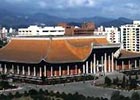 As
a famous commemorative structure of Chinese revolution built in 1931,
it was designed by the well-known architect of modern China Lu Yanzhi,
who was also The Designer of Sun Yat-sen Mausoleum in Nanjing. The building
complex is composed of the arch over the gateway, the auditorium and the
stoteyed buildings on its eastside and westside. The auditorium is octagonal
in the shape of the palace hall. As
a famous commemorative structure of Chinese revolution built in 1931,
it was designed by the well-known architect of modern China Lu Yanzhi,
who was also The Designer of Sun Yat-sen Mausoleum in Nanjing. The building
complex is composed of the arch over the gateway, the auditorium and the
stoteyed buildings on its eastside and westside. The auditorium is octagonal
in the shape of the palace hall.
With big vermilion pillars, yellow bricks and sapphire-blue glazed tiles,
the complex looks splendid and magnificent. There are 4,700seats in the
spacious auditorium, with is beamless and produces no echo. the interior
is decorated with paintings and patterns of strong national features.
In front of it there stands the statue of Dr. Sun Yat-sen.
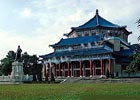 Bright Filial Piety Temple on Guangxiao Road is one of the oldest Buddhist
temples in Guangzhou and was the mansion of Prince Zhao Jiande of the
Nanyue Kingdom during the Western Han dynasty (206 B.C.-A.D.24).
Bright Filial Piety Temple on Guangxiao Road is one of the oldest Buddhist
temples in Guangzhou and was the mansion of Prince Zhao Jiande of the
Nanyue Kingdom during the Western Han dynasty (206 B.C.-A.D.24).
Bright Filial Piety Temple was first built by an Indian monk during the
Eastern Jin dynasty (317- 420) and the present temple, occupying an area
of 31000 square meters, was rebuilt it the Qing dynasty (1644 - 1911).
It enjoys great reputation in Buddhist history because Huineng of the
Zen Buddhist sect was a novice monk here in the 7th century.
The Sixth Ancestor Hall in the temple was built in memory of Huineng,
the sixth master of the Zen Sect of Buddhism, who was also the most influential
monk in the history of Chinese Buddhism.
In the temple there is also a pagoda where Huineng's hair was buried.
Other ancient structures in the temple include Sakyamuni Hall, Samgharama
Hall, the King of Heaven Hall, and two iron towers.
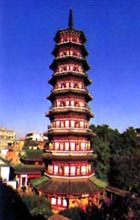 Temple
of the Six Banyan Trees, situated on Liurong Road, is a world famous ancient
Buddhist temple. It was built in 537 in the Liang dynasty during the Southern
dynasties (386-581). Temple
of the Six Banyan Trees, situated on Liurong Road, is a world famous ancient
Buddhist temple. It was built in 537 in the Liang dynasty during the Southern
dynasties (386-581).
More than 1460 years ago in the Liang dynasty, Tanyu, the master priest,
under orders of Emperor Liangwu, built Baozhuangyan Temple to store the
Buddhist bones brought from Kampuchea. During the Northern Song dynasty,
a great writer - Su Shi, on a visit to this temple was attracted by the
six banyan trees surrounding it and wrote the inscription "Liu Rong"
(Six Banyan Trees). This temple has since been known as Temple of the
Six Banyan Trees.
The temple was burned down and rebuilt in the Northern Song dynasty (960-1127).
Flowery Pagoda, built in 1097, is the major structure in this temple.
Named for its colorful exterior, the pagoda stands 57 meters high in the
center of the temple, having a bronze column with 1,000 Buddhist sculptures
on its top. Viewed from outside, the pagoda has 9 stories while in fact
it has 17stories inside.
To the west of the pagoda is Grand Hall, a magnificent hall rebuilt in
1983 with an area of 300 square meters and a height of 14 meters. In this
hall are enshrined three huge images: Sakyamuni in the middle, Amitabha
left and Maitreya right. Elaborately made of brass in 1633 during the
reign of Emperor Kangxi of the Qing dynasty, each is 6m high and weighing
10 tons, being the largest existing ancient brass images in Guangdong
province.
In the Banyan Garden, there is Hall of Liuzu, where the copper image
of Liuzu - the sixth generation of China's Buddhist master was enshrined.
This image, 1.8 meters in height and 1 ton in weight, was meticulously
cast in 989 in the Northern Song dynasty. It looks like real life, sitting
silently with eyes closed.
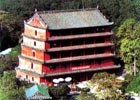 Standing on the top of Yuexiu Hill in the northern suburbs, the 28-metre-high
five-storey tower -- also known as Five-storey Pagoda -- was built on
the order of Zhu Liangzu, the Yongjia Marquis of the Ming Dynasty (1368-1644),
to flaunt his power that was able to "shake the seas and mountains".
A magnificent building, it commands a bird's-eye view of the whole city.
The tower now houses the City Museum, with exhibits which describe the
history of Guangzhou from Neolithic times till the early part of this
century.
Standing on the top of Yuexiu Hill in the northern suburbs, the 28-metre-high
five-storey tower -- also known as Five-storey Pagoda -- was built on
the order of Zhu Liangzu, the Yongjia Marquis of the Ming Dynasty (1368-1644),
to flaunt his power that was able to "shake the seas and mountains".
A magnificent building, it commands a bird's-eye view of the whole city.
The tower now houses the City Museum, with exhibits which describe the
history of Guangzhou from Neolithic times till the early part of this
century.
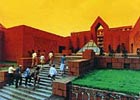 Nanyue King Tomb Museum, located in Jiefang road, is stands on the site
of the tomb of Emperor Wen, the second ruler of the Southern Yue Kingdom
dating back to 100 B.C.
Nanyue King Tomb Museum, located in Jiefang road, is stands on the site
of the tomb of Emperor Wen, the second ruler of the Southern Yue Kingdom
dating back to 100 B.C.
The tomb was originally 20m under Elephant Hill and was discovered in
1983. More than 1000 burial objects were excavated, among which are a
chariot, gold and silver vessels, musical instruments, and human sacrifices.
The tomb is 10.85 meter in length and 12.43 meters in the widest place,
consisting of the front and rear chambers. It is the earliest large-scale
painted stone-chamber tomb ever found in south of the Five Ridges.
The site is now the Western Han Nanyue King Tomb Museum.
|
|
 |
Travel
Guides |
|
|
 |
|

